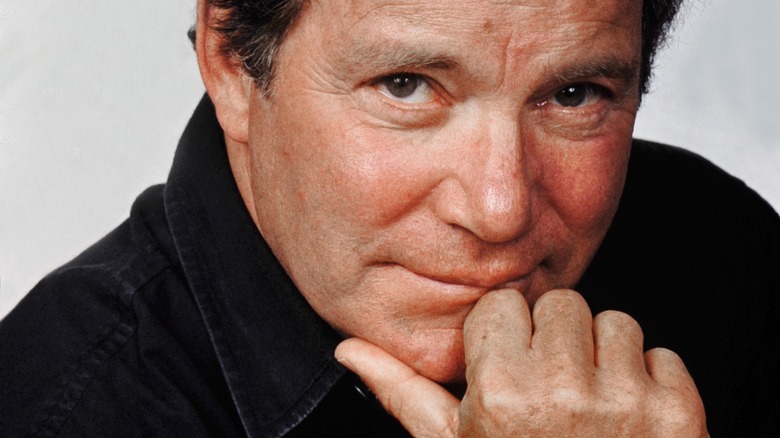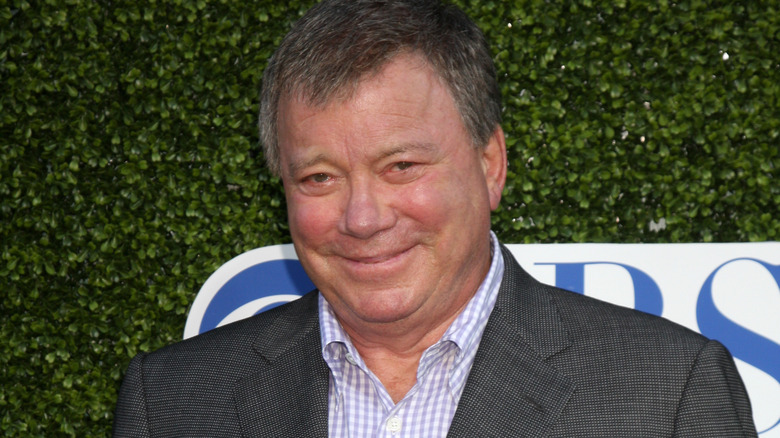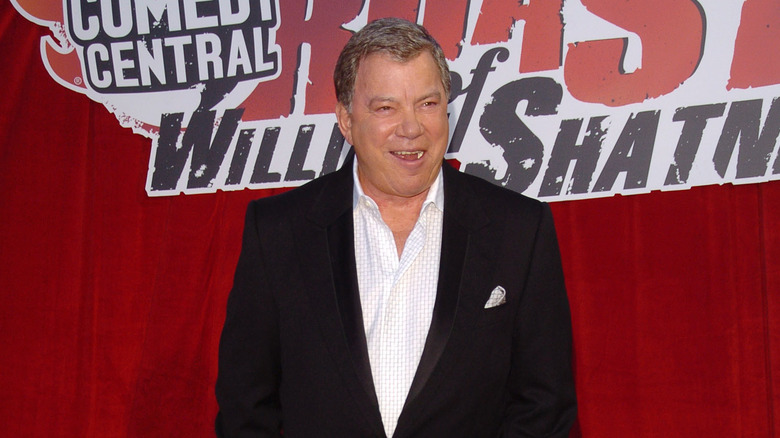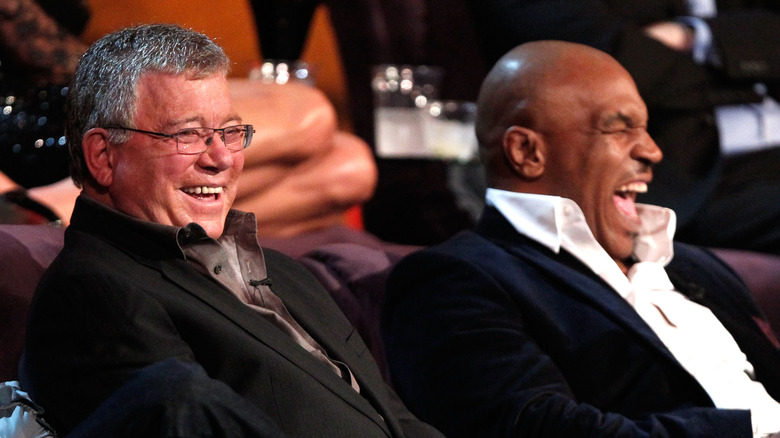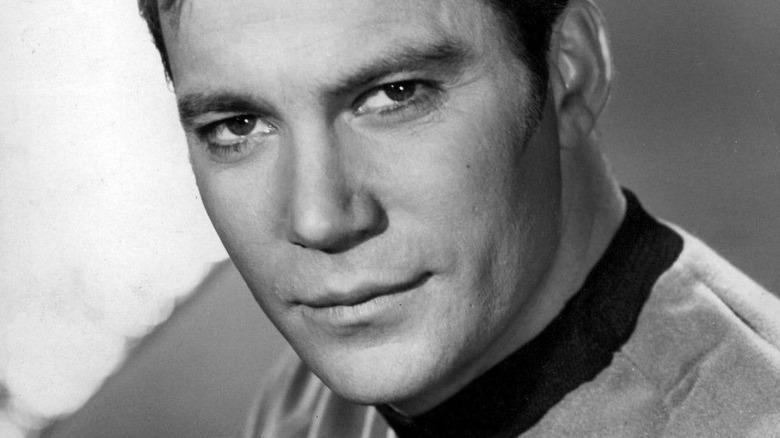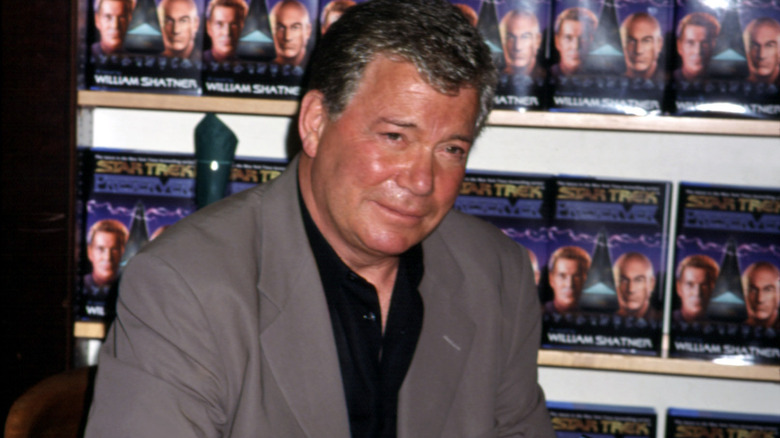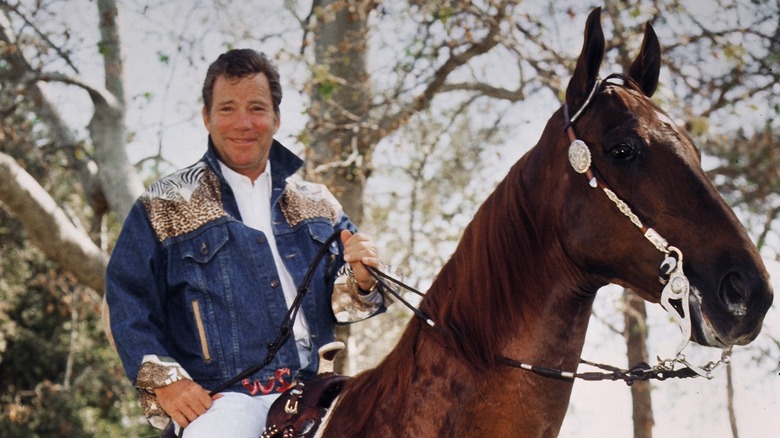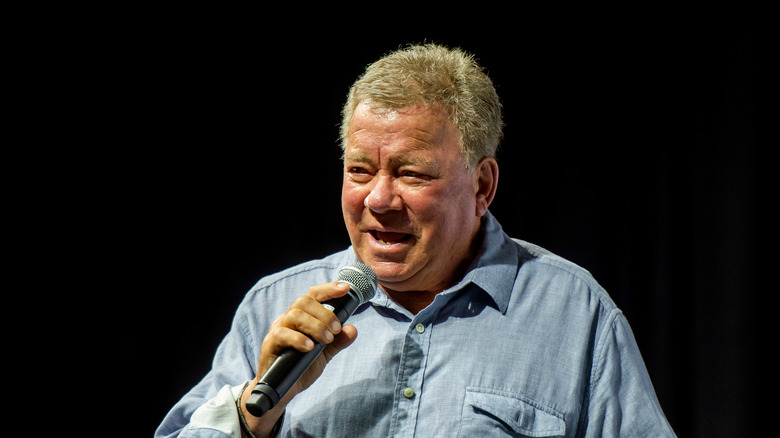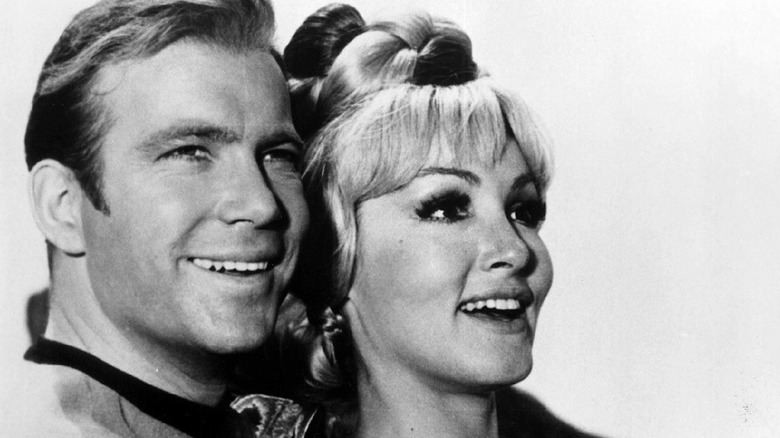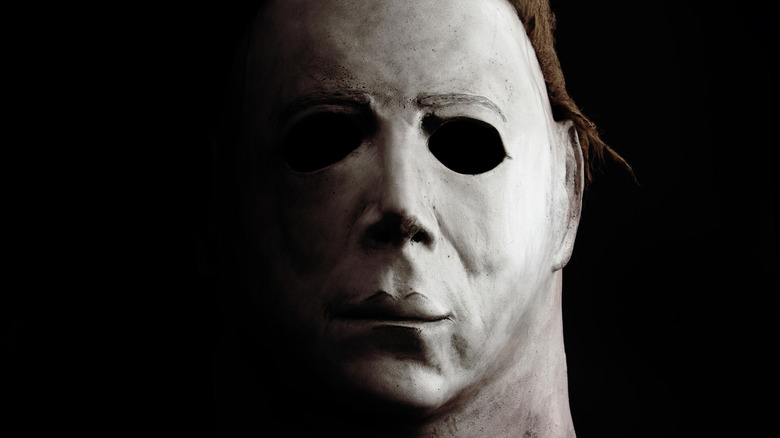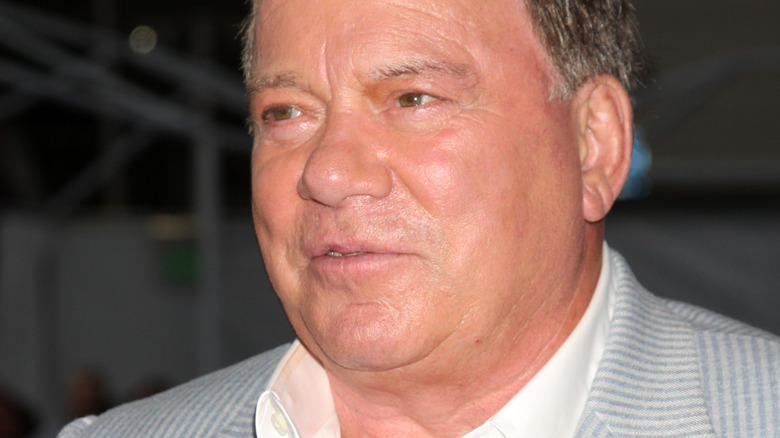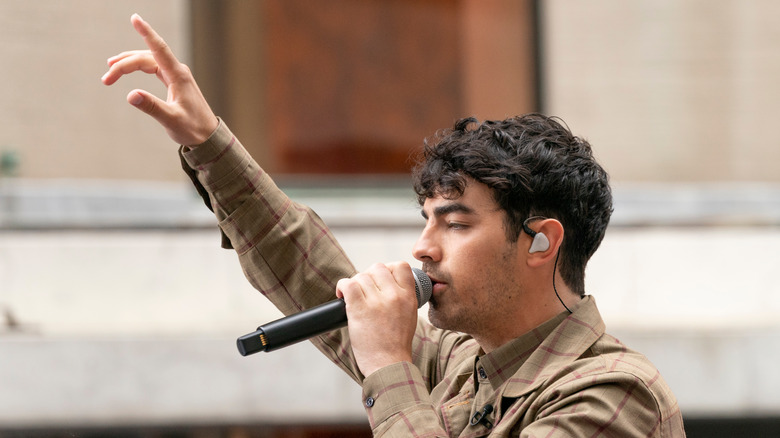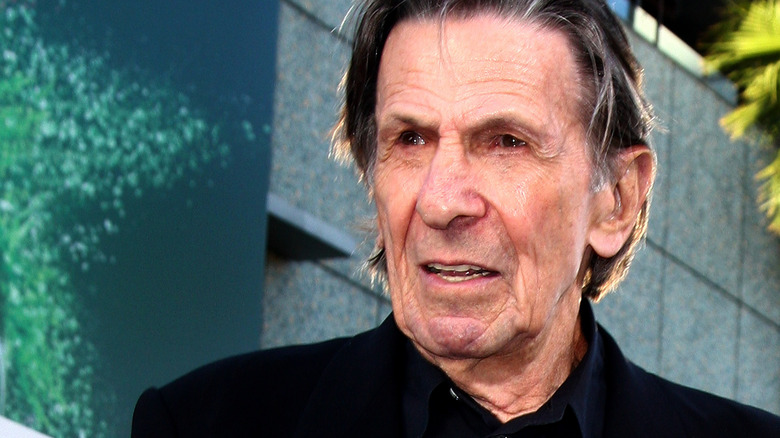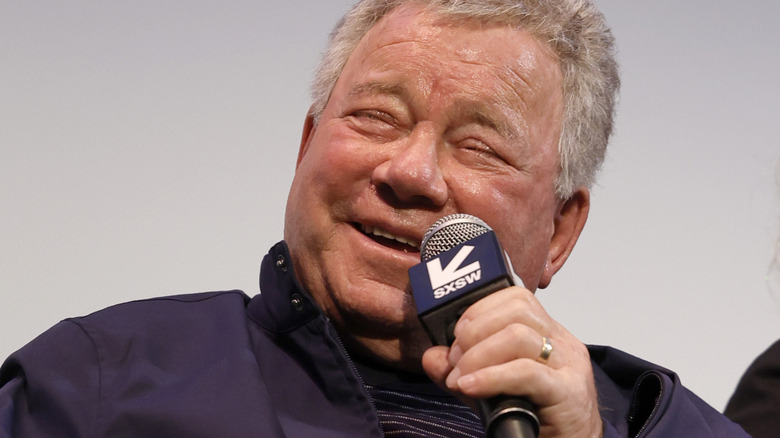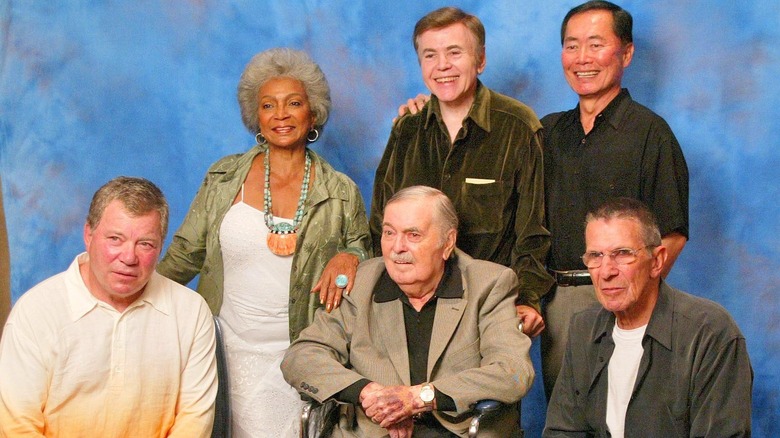14 Facts About William Shatner You May Not Know
At age 90, William Shatner broke a record by becoming the oldest man to travel to space. The "Star Trek" star spent 10 minutes on the edge of space during a flight with Blue Origin, founded by Jeff Bezos. The actor wasn't content on simply enjoying the once-in-a-lifetime experience. He used the publicity to bring attention to the environment, telling reporters (via Time): "I was moved to tears by what I saw, and I come back filled with...overwhelmed by sadness and empathy for this beautiful thing we call Earth."
Shatner, most known for the '60s sci-fi series "Star Trek," has done many things during his nine decades on Earth. He's appeared in numerous film and television productions, has released several albums, and has been successful in the horse riding, competition, and breeding industries. He's not afraid to go into the boxing ring with champions, sing with famous musicians, or fly into space at an advanced age. Shatner continues to work and shows no sign of stopping, despite being a nonagenarian. While you may know a lot about Shatner's life and career, there are some facts you may find surprising.
William Shatner was awarded Canada's highest honor
When he was 80 years old, William Shatner was honored with one of Canada's highest awards: the Governor General's Performing Arts Award. It is designed to honor Canadians whose achievements go above and beyond a regular citizen's contribution to the country's cultural life. This lifetime artistic achievement award was a big honor for the Canadian-born star, who has lived a large portion of his life in the United States. He told the Globe and Mail (via Toronto Life): "To be honored in my native country is to hark back to my youth and the joy I felt as I prepared for my life, prepared to be whatever I am now."
Shatner's entertainment career has spanned seven decades, and in addition to acting, directing, and producing, he is also an accomplished author, philanthropist, and environmentalist, according to the GGPAAF. He told the organization, "I'm an actor, a performer. There's nothing I'd rather be doing. I love to entertain, to make people laugh and cry." He has won several awards over his career, including two Emmys.
He made a Christmas album with Henry Rollins and Iggy Pop
In 2018, Shatner, who has released his share of music over the years, dropped his first Christmas album, called "Shatner Claus – The Christmas Album." It includes the actor's unique version of 13 holiday favorites, such as "Blue Christmas," "Run Rudolph Run," and "Silver Bells," according to Consequence. Like many artists, Shatner chose some high-profile collaborators to make the music even more appealing. For example, Henry Rollins joined the star on "Jingle Bells," while Iggy Pop helped him out with "Silent Night."
ZZ Top star Billy Gibbons lent his talents to "Rudolph the Red-Nosed Reindeer," while Todd Rundgren and Lynyrd Skynyrd's Artimus Pyle joined Shatner on "Winter Wonderland." Other collaborators included Brad Paisley, Jethro Tull, flutist Ian Anderson, Cars' guitarist Elliot Easton, Rick Wakeman of Yes, and folk artist Judy Collins, according to Style Weekly. Shatner appeared to have a lot of fun making the album, interjecting his own personality on classic songs and not taking himself too seriously. He leans hard into his persona, but he somehow made it work. Oh, and did we mention he was raised Jewish? That makes this album an odd production but an interesting one nonetheless.
He boxed Mike Tyson and George Foreman
In early 2021, William Shatner teamed up with boxing champ Mike Tyson in a Coppergel pain relief advertisement. He told the Express that he really enjoyed the project. He and Tyson knew each other previously, and Shatner pitched Tyson the idea. When the pair started filming in the ring, Shatner explained: "We put on the gloves and Mike started to dance around, and he moved so quickly my eyes couldn't follow him!" He noted that Tyson was in his 50s, which means he was even faster as a younger man. Shatner is a big fan of the boxer and has followed his career over the years. He admired Tyson's physical strength and "burning hunger" to win.
Tyson isn't the only heavyweight champ that Shatner has bonded with. He also knows George Foreman, and the pair starred in "Better Late Than Never," a reality travel show. When comparing Tyson with Foreman, Shatner noted that the two were "killers" when they were young and that boxing overrode their killer instincts. When filming with Foreman, the pair also had a chance to box one another. He told the San Diego Union-Tribune: "I'm a really excellent boxer, or was. My left jab kept George on his heels." He then added that he gave up the fight after Foreman hit him in the lungs.
William Shatner was homeless after Star Trek
Shatner was 35 years old when he landed the role of Captain Kirk in "Star Trek" in 1966. He talked about the strange set, the tight-fitting costumes, and the weird dialogue to the San Diego Union-Tribune. The sci-fi series that earned a cult following years later lasted just three years on air and was marginally successful. In the early 1970s, after the show was canceled, Shatner lived in a truck outside of Los Angeles for a while, so he was effectively homeless. The actor didn't have any money due to "life's circumstances," and one way to save money to support his three children was to forgo a traditional living arrangement.
"I did, indeed, live in a truck after "Star Trek", the star admitted. His family, meanwhile, was living in Beverly Hills at the time. Shatner told Metro that he had recently gotten divorced and was "totally broke." He worked on some jobs on the east coast but was not able to afford a hotel. He outfitted his pickup truck with a stove and toilet, and he would drive himself to work. He also had a dog who served as his faithful companion.
He has a doctorate degree
Before he became the actor we all know and love today, William Shatner opted for a traditional college education. He attended McGill University and pursued a bachelor of commerce degree, according to the university. He spent a lot of time in the Red and White Revue theatrical productions. He enjoyed the college experience, but he wasn't exactly a model student. "I was the single worst student at McGill," Shatner revealed during an alumni breakfast gathering a few years ago. "I enjoyed school, I just didn't go to class."
Unfortunately, Shatner failed a math course, and this minor technicality prevented him from attending convocation. In 2011, the university offered him an honorary doctorate. After graduating from McGill, he joined a theater group in Montreal before leaving for New York City and later going to Hollywood. His big break occurred when he was cast in the film "The Brothers Karamazov." Not long afterward, Gene Roddenberry came knocking after deciding to rework "Star Trek" with a new vision of Captain Kirk. The rest is history.
He loves horses and has won several championships
William Shatner loves horses and is an accomplished equestrian. He has been involved in the Saddlebred and Quarter horse industries for many years and has bred, owned, and shown a variety of horses, according to Horsey Hooves. The star has won several awards at the Kentucky State Fair World Championship Horse Show and was inducted into the World Championship Horse Show Hall of Fame in 2016. As recently as 2019, Shatner and his Standardbred road horse Track Star won the Amateur Roadster to Bike Championship.
Shatner has received ribbons in the three-gaited, five-gaited, and western pleasure classes and earned the 2018 NRHA (National Reining Horse Association) Dale Wilkinson Lifetime Achievement Award in reining. The Saddle & Bridle ASB Shatner Western Pleasure Finals were named after the actor, and the Shatner Western Pleasure Finals are held every year in St. Louis, Missouri. The national finalist at this show wins the William Shatner Perpetual Trophy. In 1990, Shatner and his then-wife Elizabeth Martin founded the annual Hollywood Charity Horse Show. Shatner also wrote a book about horses in 2017. "For most people — perhaps all? — wherever they love to be, that place is a cathedral to them ... For me, it's a stable," Shatner has said of his love of horses.
William Shatner is a trained Shakespearean actor
It's safe to say that William Shatner has a unique style of acting. He is sometimes over the top when it comes to his delivery, and he loves hamming it up for the camera. These are qualities that you wouldn't expect from a Shakespearean-trained thespian, which is what Shatner is. In his younger years, the star was a member of the Stratford Shakespeare Festival in Ontario, Canada, according to the Guardian. He joined the group after Christopher Plummer took ill and a replacement was needed to play Henry V.
Shatner also appeared in other theatrical productions in his youth. He starred in Marlowe's "Tamburlaine the Great" on Broadway, and he appeared alongside Julie Harris and Walter Matthau in "A Shot in the Dark." He was eventually able to parlay his theatrical work with film and television roles. Throughout the 1950s and 1960s, he appeared in hundreds of projects, such as "The Brothers Karamazov" with Yul Brynner. However, it took time before Shatner was able to land a leading role, and he can thank Gene Roddenberry and "Star Trek" for that.
He was not Gene Rodenberry's first choice to play Captain Kirk
It's hard to imagine anyone else playing Captain Kirk, but William Shatner was not the sci-fi show creator's first pick for the role. The pilot episode of "Star Trek," dubbed "The Cage," starred an actor named Jeffrey Hunter playing Captain Christopher Pike. The pilot was rejected by network execs, so creator Gene Roddenberry retooled it, according to MeTV. What was wrong with Hunter? Shatner wrote in his memoir, "Star Trek Memories," that Hunter was replaced because his wife constantly interfered and interjected about camera angles. In addition, NBC wanted major changes to the show's characters and cast.
Roddenberry decided to make Captain James Kirk the lead character instead of Captain Pike. In addition, three scripts were written with more focus on action scenes: "Where No Man Has Gone Before," "The Omega Glory," and "Mudd's Women." The creator's first pick to play Kirk was Jack Lord, who had an impressive acting resume. However, Lord wanted to produce as well as act, and he wanted a cut of the profits. Execs decided to go with their second choice for Kirk: Shatner. The actor happened to be a lot less expensive than their first choice, so that likely helped in their decision-making process.
The Michael Myers Halloween mask is William Shatner's face
For years there have been rumors that the mask that movie villain Michael Myers wears in the "Halloween" movies is based on William Shatner, and we can lay those rumors to rest because they're true! How it came about is interesting. The prop is a Captain Kirk death mask that was specifically created for "Star Trek," according to StarTrek.com. Several years ago, illustrator and designer Rick Sternbach, who worked on "Star Trek: The Motion Picture," "The Next Generation," "Deep Space Nine," "Voyager," and "Nemesis", revealed some details.
In 1981, he was hired as an illustrator for "Halloween." There was just one mask left from the original "Halloween," and he needed to procure more for the sequel. He wasn't sure where to look, but he noticed some words in the neck area of the remaining mask. It read "Don Post Studios" and had a model number on it. Sternbach did some research and found out it was a Captain Kirk mask. He was permitted to use more of them as long as the company was given credit.
Shatner told the Hollywood Reporter in 2021: "They made a mask of my face on Star Trek out of clay so I would not have to be available for the prosthetics they would have to put on my face to look old or evil or whatever it was they were making me look like."
He sold a kidney stone for $25,000
In 2006, William Shatner donated a very personal item to raise money for charity. The actor sold a kidney stone for $25,000, according to the Chicago Tribune. Kidney stones are hard deposits that form inside the kidneys. They can be difficult to pass, and they can get stuck in the urinary tract, which can be quite painful, according to the Mayo Clinic. Yet, Shatner had no problem selling one that he passed in 2005 to the online casino GoldenPalace.com. He joked, "This takes organ donors to a new height, to a new low, maybe. How much is a piece of me worth?"
It wasn't entirely out of left field, however, as GoldenPalace.com was known for collecting strange and unusual items, such as a cheese sandwich that looked like the Virgin Mary. The casino initially offered Shatner $15,000 for the kidney stone, but the star got the company to increase the cost by $10,000 after telling them that some of his "Star Trek" costumes sold for over $100,000. The money from the sale went to Habitat for Humanity.
At 90, he released a spoken word album with Joe Jonas
Did you know that William Shatner has released 11 albums over the course of his recording career? "Bill," released in September 2021, is a spoken word album. Themes center on his life and big-screen career, and the album includes a variety of stories and anecdotes as well as collaborations with several artists, including singer Joe Jonas, Dan Miller (They Might Be Giants), guitarist Joe Walsh, country star Brad Paisley, and musician John Lurie, reports the New York Post. Jonas played a big part in its production as it was released on his label, Let's Get It Records/Republic Records.
The 32-year-old Jonas Brothers star sings on a song called "Clouds of Guilt," which Shatner called "terrific." The actor added: "It has a depth to it and his gentle approach is not straightened and yet it's there." Shatner told ET about the project: "What better time to contemplate life's biggest questions than during a global pandemic?" He explained how some songs refer to painful or beautiful moments, while others are more philosophical in nature and deal with life and death.
Jonas, a long-time fan of the "Star Trek" star, noted that partnering with Shatner was an honor. "He's iconic," he said.
Leonard Nimoy died while in a rift with William Shatner
"Star Trek" celebrated its 55th anniversary in 2021, and friendship has been one of the series' underlying themes over the years. When the original series debuted in 1966, William Shatner and his costar Leonard Nimoy bonded and had a friendship that lasted nearly five decades. Shatner once told the New York Post that Nimoy was his dearest friend, whom he loved very much. "I loved Leonard as my dearest brother," he explained, noting that when Nimoy died in 2015 at age 83 it was as though a piece of him died as well. But like most friendships, it had its ups and downs. For example, Shatner did not attend Nimoy's funeral, although he claimed it was because he had committed to a charity event.
The pair were also at odds towards the end of Nimoy's life. Shatner revealed in one of his books that the rift may have occurred because he included his friend in a documentary about "Star Trek" even though he didn't have Nimoy's permission to do so. Still, Shatner was confused by Nimoy's decision to stop talking to him and was saddened by it. Shatner has rubbed other people the wrong way over his career. Former "Star Trek" star George Takei has called Shatner self-centered, but Shatner shrugged it off, calling Takei's attitude "a sickness."
Shatner suffers from tinnitus
William Shatner has stayed active into his 90s, and he's shared ideas about health and diet in various books and interviews. But while he eats well and keeps fit enough to manage dogs and horses, Shatner has struggled with a chronic health condition for several decades. While filming the "Star Trek" episode "Arena," he stood a bit too close to an explosion set off by the special effects team. Later in life, he experienced a persistent noise not unlike television static. Shatner had developed tinnitus.
Tinnitus, according to the NHS, is the sensation of hearing a noise inside one's body, often triggered by age-related hearing loss or exposure to loud noises like the "Arena" explosion Shatner experienced. The nature of the sound can range from the static Shatner experienced to a musical note, and it can be intermittent or persistent. While it isn't usually a sign of a serious health problem, it can greatly disrupt one's quality of life, disrupting hearing or concentration and leading to episodes of depression. Shatner has described his experience with tinnitus as an agonizing one ... at least before he discovered Tinnitus Retraining Therapy (TRT), which he discovered through the American Tinnitus Association. He was such a fan that he filmed promotional videos for the organization's efforts to support research into potential cures.
He hasn't just feuded with George Takei
Of all the items that keep William Shatner's name in the news, it seems a safe bet that his unhappy relationship with George Takei isn't his favorite. While Shatner has characterized the feud as a sick and one-sided obsession, Takei has maintained for decades that Shatner is an unpleasant egotist who alienated his co-stars. And indeed, it isn't only Takei who's had harsh words for Shatner publicly and privately.
Takei named James Doohan as one actor who'd complained about Shatner. Doohan himself told The Boston Globe, "I like Captain Kirk, but I sure don't like Bill." Unlike Takei, Doohan and Shatner may have reconciled before the former's death. At a 2004 tribute for Doohan, who was then suffering from Alzheimer's disease, the two men were said to exchange hugs and apologies backstage. They were joined by the rest of the surviving "Star Trek" cast for photos. But Shatner chose not to join Doohan and the others onstage, something Takei criticized him for.
Another "Star Trek" alum to express frustrations with Shatner is Walter Koenig. His comments have been more muted than Takei's or Doohan's. But in an interview with the Archive of American Television, he said Shatner was fun and civil but distant from everyone besides Leonard Nimoy and DeForest Kelley. Elsewhere (via an interview with TrekMovie.com), Koenig described Shatner as committing social misdemeanors, but not felonies. "We don't have closure," he said, adding that he wasn't badly affected by Shatner either.
Shatner sparked controversy over his autism comments
Autism Awareness Day occurs annually on April 2, and in 2017, William Shatner acknowledged it with a post on Twitter. While the tweet was well-intentioned, it included the logo for Autism Speaks, a controversial organization among those with autism and the medical community. Some have found the group's messaging to be dehumanizing, and it's been criticized for supporting research on prenatal causes over care and support for autistic people. At times, Autism Speaks has seemed sympathetic to unfounded fears that vaccination can contribute to the development of autism, despite publicly encouraging children to be vaccinated.
Shatner's tweet drew heated commentary from fans and advocates. Many remarks mischaracterized the original tweet or falsely claimed Shatner was anti-vaccination, and he turned hostile and defensive in replies. When Dr. David Gorski, founder of the website Science-Based Medicine, posted a thread explaining the issues many have with Autism Speaks, Shatner began sharing attacks on Gorski's credibility he found on Google, despite many coming from uncredible sources.
After several days, Shatner put the blame for the controversy on his critics. "All I did was put up an icon [and] a hashtag," he tweeted. "If they just kept quiet it would have been gone the next day until next year."
